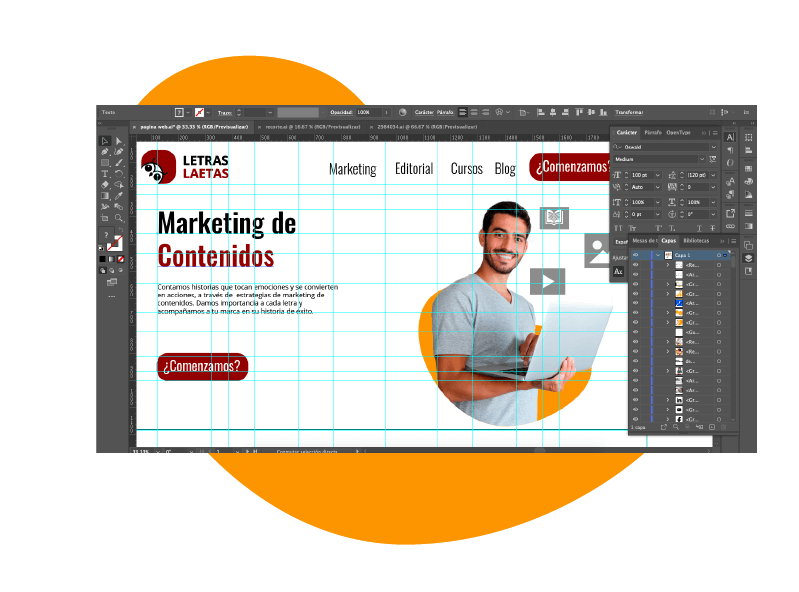
Why make your site with us
We listen to you
We listen to your ideas and suggestions so that the final development of your site is the way you imagined it.
We want to see you happy
Our greatest achievement is to meet and exceed our clients’ expectations.
We value your time
That’s why we do a detailed planning and stick to the initial schedule.
We know the tools
We have a decade of experience building websites for different clients.
We teach you how to use it
We deliver a detailed tutorial on how to manage the site and make updates.
We provide infrastructure
We can host your site and manage the purchase of the domain name.

Design and development of professional websites has several stages:
- Planning. In this stage, the designer makes a wireframe in which, without colors or going into the details of the graphic design, makes a scheme of the website layout.
- Design. Once the functionality of the site is clear, we proceed to dress it with institutional colors, images and fonts.
- Development. After the design is approved by the client, the website is programmed. Depending on the project, it can be developed from scratch or based on a content manager or CMS.
- Functionality tests. When the development is done, the different interactive sections are tested, for example, the contact forms, the content filters, etc.
- Delivery and training. Finally, we deliver the website to the client and all the credentials to manage it.

Wireframe
Although the wireframing step is often skipped, this stage is important especially if the website will have complex features or be very large. In addition to accommodating the elements of the site, it indicates what will happen when certain buttons are clicked, among other functions. It can be drawn by hand or made with specialized software, it is not interactive, it is only a model without color, images or definitive texts.
In case the functions are too complex, in addition to this scheme, a flow chart can be made. This chart specifies the processes of the website. In most cases the websites are merely informative and it is not necessary; however, it is essential for developments that are more complex than a standard website, such as mobile apps.

Website graphic design
The next step is to dress the website with the images, colors and fonts of the brand. To do this, if the client has a graphic identity manual or a corporate identity manual, we base ourselves on the indications that the graphic designer of the company has previously defined.
If there is not a manual, we make a proposal based on the logo, on the previous materials of the brand or on reference websites whose design seems attractive to the client.
In this step, if the texts that will be definitively placed are not yet available, sample contents are loaded. This stage can have one or several rounds of changes until the client is 100% satisfied with the design of the site.

Website development
The development consists of translating into code the design that already have for the site.To do this, the programmer uses languages such as HTML, CSS and Java Script, among others.
Although some people think that it is always better to develop from scratch, this idea is wrong. There are frameworks and content managers or CMS (content management systems) that reduce development times and facilitate work of equal or higher quality than development from scratch.

Testing
The tests include verifying that the contact forms are executed correctly, that clicking on each section of the site responds appropriately to the user’s queries, that the navigation is intuitive and simple, among others. The type of tests depends on how many functions the website has.

Delivery
Once we finish the development, we deliver the website to you in a .zip file along with the database, all the credentials and a user manual.
If you decide so, we can also provide you with the hosting service and manage the purchase of the domain name for you.
We may also train you or a member of your team on how to make updates to the website.
FAQ
Content marketing is the right arm of traditional and digital marketing strategies; good content has the ability to inform, move, generate actions and awaken emotions in those who consume it. For something the famous phrase “content is king” is still valid.
Content managers are applications that are installed on a server and make it easy to upload text, images and other multimedia content. One of the most popular and the one where our team develops most of the sites, is WordPress. This makes it easier for the client to have greater control over their content and not be dependent on highly specialized technicians to carry out updates on their website.
A development from scratch will always have the enormous advantage that you will be the only owner of the code and you will be able to control every aspect of how your system works.
However, for most cases in which companies or individuals require a website, content managers are an adequate solution to easily and quickly publish on the web. In addition to the fact that loading and modifying new content can be done relatively easily and will not always require a professional developer to make changes.
The development time for an average website is 15 to 20 days, considering that it has a maximum of 20 pages. This time depends on the client providing the necessary information, as well as feedback at the end of each stage of development.
In the case of websites with ecommerce systems, the time may increase since it is necessary to make agreements with shipping companies, among other technical aspects that require, at least, a month and a half of time.
Once we finish the development, we deliver the website to you in a .zip file along with the database and a user manual. If you so decide, we can also provide you with the hosting service and manage the purchase of the domain name for you. We may also train you or a member of your team on how to make updates to the Page. We give you all the access and credentials so you can enjoy your website.
Depending on the complexity and technical specifications of an average website, the cost can range from 500 USD to 5,000 USD or more.
For example, a onepage or single page website would be in the lowest rank. Likewise, a landing page, which is also a single page website but focused on SEM campaigns, would fall within this range.
A corporate website with 10 or 15 pages on average is around 1,300 USD, while more robust pages and ecommerce systems increase the cost of development.
YOU MAY BE INTERESTED…
A selection of articles from our blog.
Is your company looking for a content marketing solution?
We are ready to make your ideas come true. Let’s talk about it!





